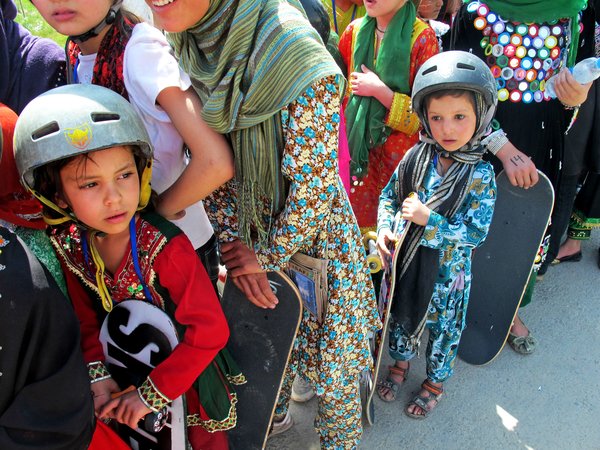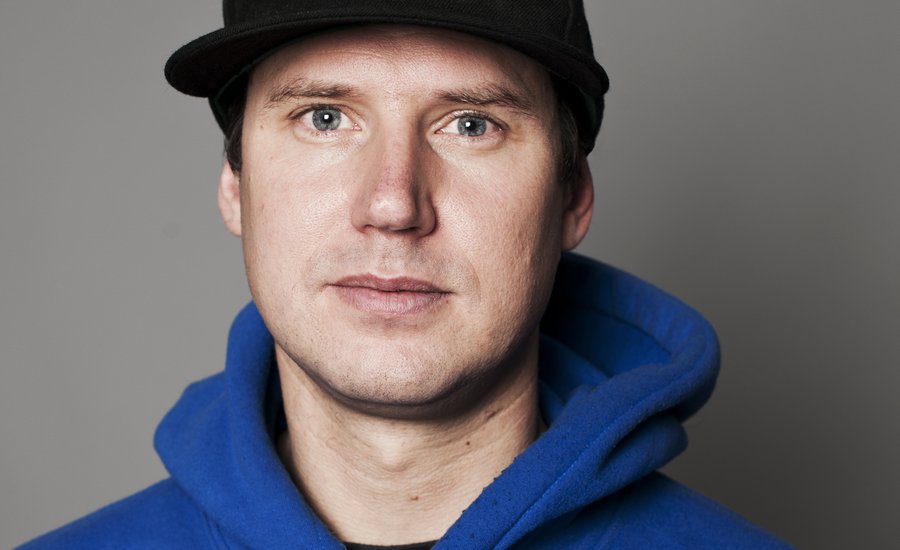When the Australian skateboarder Oliver Percovich first came to Kabul, Afghanistan, in 2007, he wasn’t trying to rebuild the country or empower its youth. He wasn’t really even trying to skateboard—he was looking to continue his work as a research scientist. It wasn’t until he pulled out his board and started skating around the city that he saw the potential this anti-authoritarian sport held to build sorely needed confidence and connections among the young people of the city. What’s more: girls were just as interested in shredding up the city as their male counterparts, a rare sight in a largely gender-segregated society. Percovich started organizing skate sessions around the city, with the goal of both spreading the gospel of gnarliness and providing constructive alternatives for the Afghan children he met.
Eight years, three skateparks, and hundreds of thousands of dollars in donations later, Percovich and his organization Skateistan are still hard at work building facilities and communities to empower at-risk youth. They’ve expanded their activities to include education and the arts, built new compounds in Mazar-e-Sharif and Phnom Penh, Cambodia, and linked up with the Skateroom, a company headed by the former gallerist Charles-Antoine Bodson that has pledged to support the NGO’s activities—including fully funding their new skatepark in Johannesburg, South Africa—through the sales of their commissioned, artist-designed skateboards. Artspace’sDylan Kerr called into Kabul to talk to Percovich about how he fights violence and poverty with skateboards and kneepads, and the unlikely ways in which the art world is helping him.
RELATED ARTICLES:
Can Artists on Skateboards Change the World? A Q&A With the Skateroom’s Charles-Antoine Bodson
How did you first get interested in this kind of work?
I first traveled to Afghanistan in 2007 because my girlfriend at the time had a job in Kabul. I’ve been a skateboarder for almost 30 years, so naturally I brought my skateboards with me. At some point, I pulled a board out and started roaming the streets. I eventually got into a few skateboard sessions with kids, and I was really interested to see that girls as well as boys wanted to do it. I didn't see girls doing any other kinds of sports, so I thought that this was maybe something worth looking into. When I heard the statistic that almost half the population of Afghanistan is under the age of 15, I thought, “This is definitely something that has potential.”
I started doing little sessions with kids on the street in Kabul for about a year and a half, using virtually no money at all. I was working it out however I could—I had a little website going and I had a few donations come from overseas. In doing these sessions, I worked out that the thing they really needed was access to education. Another key thing that I saw was that the lack of trust between foreigners and Afghans, and between the different ethnicities in Afghanistan, was really undermining a lot of efforts to help. Without trust in the equation, money doesn’t do very much at all.
How does skating address these issues of education and trust that you’re referring to?
No foreigner is ever going to change things in Afghanistan over the long term, so education really is an investment in the kids and in the country. Afghans are the ones who can make changes in their country, because they’re the ones who actually understand how things work. The international community had simply tried to solve the problem with money—$500 billion later, they don’t have that much to show for it.
In the skate sessions that I was running, we had both boys and girls of different ethnicities. There were very, very poor kids that were begging on the street as well as some more well-off kids. I noticed that skating was building trust and relationships on a micro-scale among these 50 kids. That’s really where the idea came from to do something a little bit bigger, to approach different donors in Kabul. I ended up working with the president of the Olympic Committee in Afghanistan, and he gave us a plot of land. We had early donor help from a few different countries as well, including Denmark, Norway, and Germany. With their help, we built the largest indoor sports facility for young Afghans in the country—it’s a skatepark with classrooms attached. That effort showed how this micro-project could be scaled up.
What is it about skateboarding that’s proven so popular amongst Afghan girls?
Skateboarding is now the largest sport for girls in Afghanistan. The reason is simply because it was a brand new sport in a place where girls are prevented from doing a lot of other sports—they’re seen as activities just for boys. If a girl tries to play soccer, she’ll be told, “Don’t do that, that’s for boys.” Girls don’t ride bicycles in Afghanistan, they don’t play volleyball, they don’t fly kites—any of the popular activities that boys do are very, very hard for girls to get into. Because nobody had seen a skateboard before, when I started to get girls skating right from the start it was actually seen as a sport for girls at first. It was kind of a loophole, and I exploited it as much as I possibly could. As these girls grow up, it’ll be interesting to see where it goes.
 Image: Rhianon Bader
Image: Rhianon Bader
Your website says that you use skateboarding as a “hook” to get kids interested. Once they're hooked, what other kinds of programming do you offer?
We run three main programs. The first is called Skate and Create, which is one hour of skateboarding and one hour of creative arts class. We’ve got a Back to School program, which is accelerated learning where street and working children who don’t go to school at all do first through third grades in the span of one year and then go straight into the fourth grade in regular school. We help them enroll them, and we work with the Ministry of Education in order to do that. Children who are really active in the organization and want to do more can then become Youth Leaders, where they volunteer to be teachers in the classroom activities or the sports.
Within the Youth Leadership program there’s also the opportunity to travel overseas—a couple of kids from Kabul just came back from Qatar and another one went to Sweden and Germany recently. Our contacts from around the world have allowed us to create these opportunities for the kids, and it’s really about helping them build up their skills so that they can transform their country.
What’s your approach to education in the context of your organization?
I really thought it was important that the kids learned how to think in different ways. We created a curriculum based around the creative arts, with the idea that class wouldn’t just be about repetition and regurgitating information without really processing it. Art-based activities provide a level playing field for children from all different backgrounds, and having both really poor kids and some more educated kids creates the opportunity for peer-to-peer learning.
This kind of instruction is something that works very well in the skatepark especially, where the poorer kids were the bigger risk-takers and therefore became the best skateboarders. The more educated, richer kids looked up to them for the first time in their lives. They made connections—there was trust, there was social capital there, and they took that into the classroom. The more educated kids, who had made that connection through skateboarding, were then helping the other kids with photography, painting, or sculpture, different activities that don’t require literacy or numeracy. The idea was that all kids could get involved with it.
What are some of the challenges you come up against?
We’re working against two main forces at the moment—first, many Afghans are trying as hard as possible to leave the country and go to Europe and elsewhere, and we’re trying to work completely against that. We want them to stay and build up their country.
Second, we want to provide an alternative to whatever other influences are out there. In Afghanistan the children are often ignored, and that’s where negative pressure can step in. If they don’t have good schools or jobs to go to, there need to be other influences for them. We want to provide an alternate narrative for the kids.
Despite your name, Skateistan operates in regions beyond Afghanistan. What other projects is the organization involved with?
Since Kabul, we’ve expanded to Phnom Penh in Cambodia, and then started another project in Mazar-e-Sharif in the north of Afghanistan, where we built a facility three times the size of the one in Kabul. We’ve now got about 1,300 kids in Afghanistan who come weekly, all between the ages of five and 17. We’ve also got a brand new skatepark project in Johannesburg, South Africa, that we’ve been working on more recently.
 Image: James Darlington
Image: James Darlington
That Johannesburg project is being funded by Charles-Antoine Bodson and his business the Skateroom. How did the collaboration with the Skateroom come about?
We first came into contact with the Skateroom a few years ago. Charles had heard about Skateistan and the work that we do, and he’d been a skateboard deck collector for a long, long time. He had one of the biggest collections of decks I’ve ever heard of, maybe one of the largest in the world. He had this idea of starting to create skateboard art to sell in support of Skateistan. It was very exciting when he first proposed the idea—he threw some pretty big names out there, but nothing compared to what has actually eventuated. I’m almost in disbelief at the sort of people he’s been able to get on board.
The Belgian street artist ROA came out to Cambodia and spent some time there, which was an early connection with the project. After that, there were a couple of different collaborations, where every time they’d sign on a new artist, we would get $10,000. That was an amazing, really cool collaboration, but then they really stepped it up with the connection with Paul McCarthy. Paul’s son Damon is around my age, 41 or 42, and comes from the same era of skateboarding, so Damon was especially interested in the project. Together with Paul, they came up with a way to produce a limited edition of Paul McCarthy skateboards that is actually funding our whole facility in South Africa. It’s a two-story art-education complex that we’re building, with a massive concrete skatepark in the back. Paul McCarthy really started to work together with us, and I’ve met up with him and Damon on numerous occasions now.
Our relationship with the Skateroom has just grown more and more, and now Charles has proposed that the Skateroom will just support Skateistan—that’s what they’ve always done, of course, but it wasn’t set in stone. He’s now committed to completely supporting Skateistan through these artist collaborations, the latest one being with the Andy Warhol Foundation. The release happened just last week, during Art Basel Miami Beach.
How do the art and skateboarding communities fit together, and how does this match-up lead to support for your projects and long-term goals?
I think that art and skateboarding have always gone together rather closely—there’s a lot of appreciation for art in the skateboard world, and the skateboard world itself also produces its own branch of art. That said, the Skateroom is putting fine art on skateboards on a level very rarely been seen. The fact that they’re doing one collaboration after another has us all excited. For me, it means that our project is expanding globally.
In terms of our goals, it’s important to understand that there’s less political will now for supporting projects in Afghanistan. While we do work with donors from the U.S., Finnish, and Swiss governments in addition to online fundraising efforts, the amount of money coming in from these sources is dropping. We want to be able to continue to do what we do, and what Charles is proposing is to basically support us in place of these governments. With government donors, you’re working with an entity whose actions you don’t necessarily agree with at all—it’s money that we’re grateful for, but we’d prefer to have other donors too. The fact that the Skateroom can provide the same levels of support—in the hundreds of thousands of dollars—and that we can use that to do something we love is absolutely incredible.
RELATED ARTICLES:
Can Artists on Skateboards Change the World? A Q&A With the Skateroom’s Charles-Antoine Bodson



























